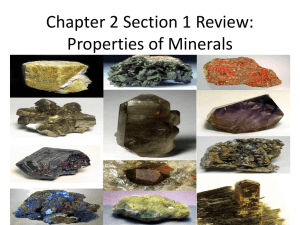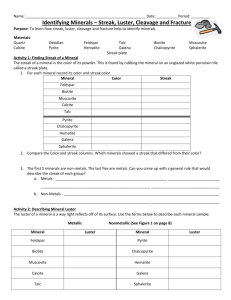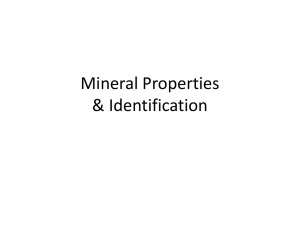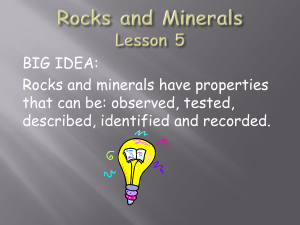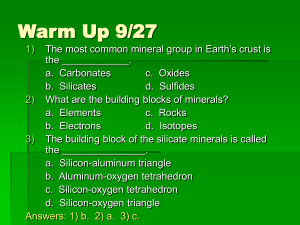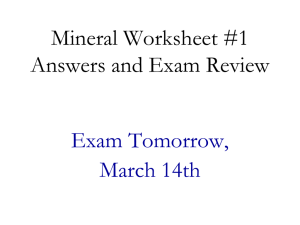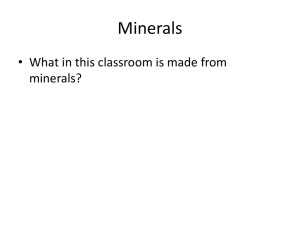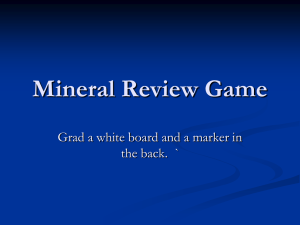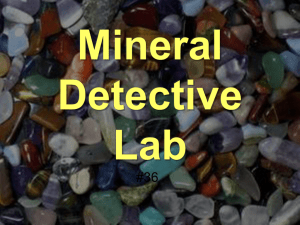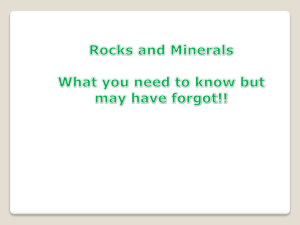Mineral Lecture
advertisement
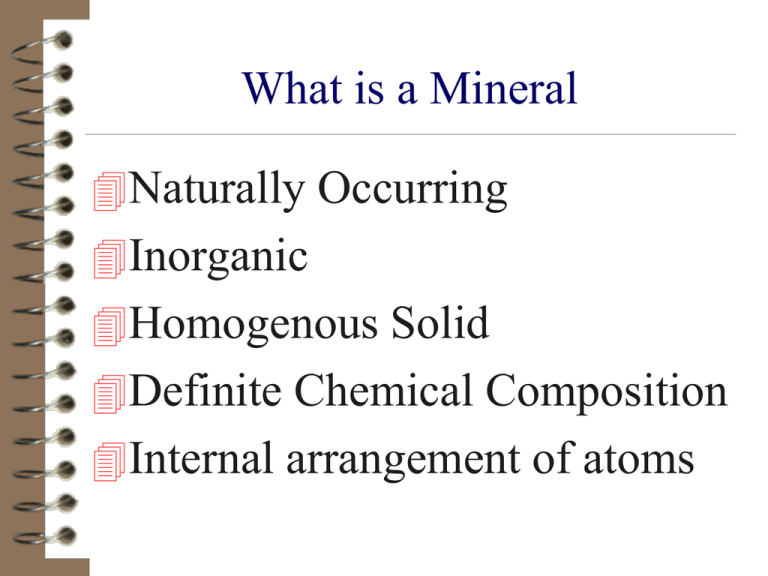
What is a Mineral Naturally Occurring Inorganic Homogenous Solid Definite Chemical Composition Internal arrangement of atoms Properties of Minerals Each mineral can be identified by its unique properties. For example: •Galena can be identified by its very high density and its cubic cleavage. •Quartz can be identified by its luster, lack of cleavage and hardness. • •Mica can be identified by its cleavage. •Sulfur can be identified by its color. •Magnetite is magnetic. •Calcite fizzes when hydrochloric acid is dropped onto it. Why do minerals have certain properties? The properties of each mineral are determined by its internal arrangement of atoms. Do Now 1. Why do humans use minerals? 2. How many minerals can be found on Earth? 3. 90% of all rocks are made of up _____common minerals?(how many) 4. What is a mineral? Major Properties Color- what it looks like to our eyes Luster- how the surface reflects light Streak- color of the minerals powder Hardness- how resistant to scratching Cleavage- breaking along surfaces Density- packing of atoms Crystal Shape- angles between sides ColorSome minerals are easily identified by their color. Many minerals come in a wide variety of similar colors so it is only occasionally useful. Sulfur Sulfur can always be identified by its bright yellow color. Pyrite Pyrite can be identified by its brass yellow color. Luster Luster is the way light is reflected from a freshly broken surface of the mineral. Metallic- metals do not let any light penetrate. Therefore, they reflect all the light hitting their surfaces. Nonmetallic- nonmetals allow some light to penetrate so they will appear very different from metals. Metallic Luster Galena has a metallic luster. Nonmetallic Luster Calcite has a nonmetallic luster. Hardness Hardness is the resistance to being scratched. Hardness is a measure of how tightly the atoms in a mineral are bound together. The test for hardness is to scratch two objects against each other. Hardness If one object scratches another it is harder than it. Friedrich Mohs created a scale of hardness a called the Mohs scale. Talc is softest (1), diamond is hardest, (10). Mohs’ Hardness Scale 1-2.5 Fingernail scratches mineral 2.5-3.5 Fingernail does not scratch mineral, mineral does not scratch penny. 3.5–4.5 Mineral Scratches penny, Nail scratches mineral. 4.5-5.5 Nail does not scratch mineral, Mineral does not scratch glass. 5.5-6.5 Mineral scratches glass, file scratches mineral. 6.5+ File does not scratch mineral. Cleavage- from latin (to cut or cleave) Cleavage is the tendency to break along lines of weakness. If a mineral breaks along flat surfaces it is said to have cleavage planes. These surfaces may or may not be parallel to the planes of the crystals. Cleavage- parallel to the surface Mica has perfect cleavage in one direction, parallel to the crystal faces. Cleavage- parallel to the surface Halite (rock salt)- Natural crystals form cubes. Cleavage- parallel to the surface Halite -breaks into cubes. Diamond Concoidal Fracture- curved, not parallel to the crystal surfaces. Obsidian (volcanic glass) breaks along curves. This is called concoidal fracture. Even though quartz has crystal faces it only has concoidal fracture. It never breaks parallel to the surface. (No cleavage.) Streak The streak is the color of a mineral’s powder. A streak is made by rubbing the mineral over an unglazed ceramic tile. If the mineral is not as hard as the tile some of the mineral will rub off. Streak The color of the powder can be easily seen against the white tile. If the mineral is harder there will be a white streak. Some metallic minerals have a different color streak than the color of the mineral. Streak To make the streak test just carefully rub the sample on the streak plate. Streak is very reliable, any mineral always has the same color streak. Streak Hematite always has a red streak, no matter what color the sample of hematite is. Crystal Faces If a mineral is allowed to grow without bumping into anything else it will grow in very specific ways that represent its basic internal arrangement of atoms. Crystals of Galena Galena crystals are cubes because the atoms arrange themselves that way. Crystal Faces Crystal faces meet at specific angles for each mineral. These angles may be used to identify the mineral but can only be used for crystal faces, which are rare. Density and Specific Gravity Density is a measure of how tightly packed a substance’s atoms are. Specific gravity is the ratio of the density of a substance to the density of water. •Water = 1 gram/cm³. •Galena = 7.5 gram/cm³. •Galena has a specific gravity of 7.5. Density Density is a derived unit that is a comparison of the mass of an object to its volume. D= mass/volume The formula for density is found on the front page of the ESRT Here’s a trick! Cover the unit you are trying to calculate and the formula is what is left. The Law of Density if matter is less dense than the matter surrounding it will rise until it reaches a density that is equal to its own density. Substances that are less dense will float. Substances that are the same density can stay suspended. Substances that are more dense will sink. The density of a substance does not change when broken. All the pieces of a broken substance remain the same unless the temperature changes. Air is heated it expands. Its volume increases therefore the density decreases. Water is special! Water has a density of 1g/cm at 3.98EC (front cover ESRT) Water is most dense at 4°C. Ice is less dense therefore it floats. Most objects are more dense as a solid except water. Density and Specific Gravity •Most rocks have a specific gravity of 2.5 to 3.5. That means their density is 2.5 to 3.5 grams/cm³. •Lead is 12. •Gold is 19. Gold is the most dense common substance. Special Properties •Magnetism- magnetite attracts magnets, strong magnetite attracts iron. •Double refraction- clear calcite will transmit two images of an object. •Acid- calcite will react to HCl. •Flourescence- some minerals glow in UV light.
